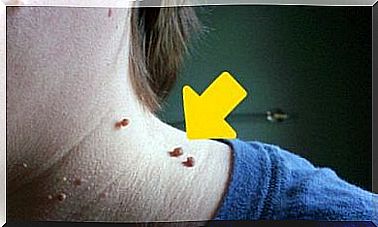Dental Bridge: Types, Advantages And Disadvantages
The dental bridge is a fixed denture that can be used to compensate for missing teeth in the mouth. How is it used? What are their advantages? At this point we tell you all about it. Read on!

If there are no teeth in the mouth , the dentist may suggest placing a dental bridge. This is an alternative that will allow you to restore the aesthetics and functions that are lost with the loss of teeth.
But what is that? What are the pros and cons? This is very controversial. That’s why we want to show you in detail what it is, what types there are and what the main advantages are. Read on!
What is a dental bridge?
A dental bridge is a type of fixed denture that is used to replace one or more contiguous tooth elements that are missing in the mouth. In particular, it covers the area of missing teeth with artificial crowns. These are attached to the healthy teeth that the person still has.
However, in order to be able to attach the dental bridge to the neighboring teeth, they must be ground down beforehand. This means that the bridge is attached to the ground teeth. This means that the patient cannot remove the prosthesis, so it remains firmly in the mouth.
With this type of restoration, functions that are lost if one or more teeth are missing can be restored. These include aesthetics, closure, chewing ability, face shape, language and pronunciation.
In general, dental bridges can be made from the following materials:
- Metals
- Resins
- Ceramics
- porcelain
- Ceromers

Also read: What is an open bite and how is it corrected?
How do you make a dental bridge?
After the dentist has made the diagnosis and decided together with the patient to solve the missing dental elements with the insertion of a dental bridge, the following steps are necessary for the insertion:
- Grinding the abutment teeth: The doctor grinds the surrounding teeth with the turbine under prior anesthesia. These elements are called abutment teeth because they will be the support of the bridge.
- Taking an impression: The doctor takes impressions of the mouth and sends them to the dental laboratory so that the bridge can be made.
- Temporary plastic crowns : Temporary crowns are made for the analysis model, which are placed on the ground abutment teeth for the duration of production. In this way, the aesthetics and health of the worn elements are preserved.
- Metal sample: The metal frame of the bridge is tested to see if it is properly seated or if corrections are needed.
- Color test: You take the patient’s color and send it back to the laboratory.
- Insertion of the bridge: Insert the complete bridge and make adjustments. Then it is sent to the laboratory one last time for finishing and polishing.
- Strengthening the bridge: A special cement is applied to the ground abutment teeth and the bridge is then inserted.
- Follow-up checks: After a while, the dentist will make another appointment to check that everything is in order.
What types of dental bridges are there?
There are different types of dental bridges. The most important are the base, cantilever, Maryland and implant-supported bridges. The choice of one or the other depends on the individual case. The dentist guides the process and caters to the individual needs of the patient.
Basic dental bridge
The base bridge is used when there are natural tooth elements on both sides of the missing teeth. This is how you fill this gap with one or more artificial teeth that are supported by crowns. These are cemented over the abutment teeth on each side.
The chewing force is better distributed and supported by the support pillars on both sides . For this reason, they are usually chosen for the rear area.
Cantilever dental bridge
The cantilever bridge is similar to the base bridge, with the difference that it is supported by a single abutment tooth. This means that in this case you only need one natural tooth next to the gap created by the missing teeth.
The dentist must grind the tooth chosen as the abutment tooth. The crown is then cemented over the bridge, which will later hold the artificial teeth to fill the empty space. Since they only have one point of support, they are also less resistant. Sometimes they break or come off due to the leverage created when chewing.
Maryland Dental Bridge
These bridges use two natural tooth elements as pillars, one on each side of the gap. The difference to the basic bridges is that they do not use crowns on the abutments, but side wings made of metal or porcelain that adhere to the back of the surrounding teeth.
In order to use them, it is necessary to have a natural element on either side of the space created by the missing teeth. Here the cut is much lower, so it’s the most conservative option. In any case, it can only be used in areas with little occlusal stress because they cannot withstand as much force.
Implant-supported dental bridge
As the name suggests, these bridges use implants instead of crowns over the ground teeth. In order to place them, you have to perform a surgical procedure that uses implants to support the bridge.
Usually two surgical procedures are required: one to place the implants and one to place the bridge. It can take several months to complete the entire process.
The number of implants and their placement vary depending on the patient. It can be placed one in the middle, one for each missing element, or one at each end of the gap.
This type of dental bridge is the most stable and the one that best withstands occlusal loads. It is usually also the most comfortable for the patient and also the only one that avoids bone resorption in the edentulous areas.
advantages
Placing a dental bridge has both aesthetic and health benefits. Once the procedure is complete, the person can chew and eat normally again. It also improves your pronunciation as there are no empty spaces that can cause involuntary sounds, whistles, or other noises.
From a purely aesthetic point of view, having all your teeth in your mouth strengthens self-confidence and self-esteem . It prevents teasing and enhances the external appearance by maintaining the natural face shape. A dental bridge takes the place of the missing teeth and prevents the remaining teeth from moving and changing their position.
Since it is firmly anchored in the mouth, it is easy to care for and it is cleaned like natural teeth. The person usually gets used to it quickly and perceives it as a normal part of the mouth.
The cost of a dental bridge has a notable advantage. The dental bridge is durable and therefore much cheaper compared to implants.

You might also be interested in: oral care for children
disadvantage
Before deciding on a dental bridge as the solution to missing teeth, it is necessary to understand the disadvantages of it. Here are some of them:
- Abrasion Abutment Teeth : The main disadvantage of this type of denture is the need to abrade healthy teeth. Sanding them off increases the risk that they will suffer further damage. In some cases, a root canal treatment is even necessary. In addition, these parts must always be covered with a crown, as their shape is changed.
- Aesthetics: Since it is made of metal, the abutment teeth or gums can be discolored or soiled.
- Risk of leaks: The space between the abutment tooth and the crown can cause caries to form under the cemented crown.
- Risk of displacement: abutment teeth can move, especially if they have to withstand high occlusal loads while chewing. It is therefore not advisable to use it on patients with harmful habits such as grinding teeth, biting nails, or biting objects.
- Bone resorption: The bone, in which there are no tooth elements and therefore no stimulus, is resorbed.
- Shelf life: They can usually stay in the mouth for several years, but do not last quite as long as implants.
- Risk of inflammation of the gums: Bacteria can accumulate in the space between the bridge and the gums and cause inflammation of the gums.
It is important to seek advice from your dentist
Dental bridges are a great option to replace missing teeth in your mouth. Still, it is important that you consult your dentist before opting for this method.
Your doctor will help you clear any doubts you have about materials, types, designs, and attachments. He / she will also assess whether there may be any disadvantages. Note this!









